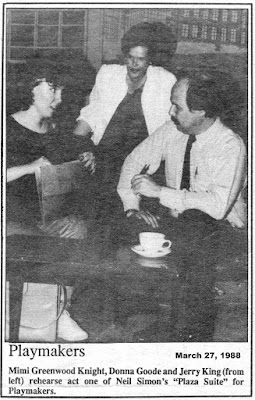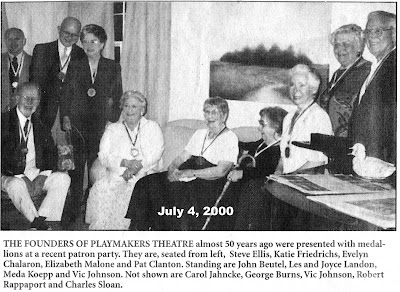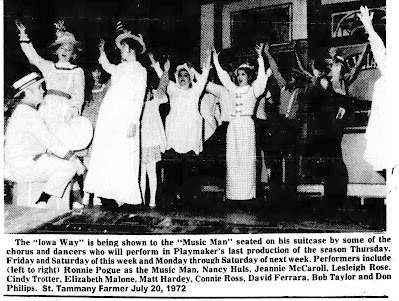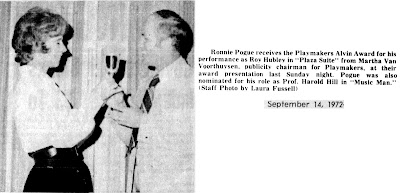My newspaper article written to tell Playmakers story is below. It was written in 1973 from many of the aforementioned sources, mainly though just through friends of mine who like to share their involvements with the area's premiere little theater effort.
Click on the images to make them larger.
Page One
Page Two
The "King and I" Program
"The Gazebo" in 1966
-----------------------------------
In 1978, the following press release was sent out by Playmakers, Inc.
Playmakers Inc. was chartered in 1955 as an all-amateur, non-profit community theater serving the Covington area. In the past 28 years, it has grown to include members from all over the southern half of Louisiana, but has never operated for profit or maintained a hired staff, making Playmakers perhaps the oldest continuously operating all amateur theater in the United States.
The original old Barn (Photo by Ron Barthet)
It has been traditional for Playmakers to produce four plays during the year, one of which is a musical.
Then came the actual fire.
In July of 1976, while in rehearsal for Guys and Dolls, a fire destroyed the Playmakers theater, a 75 year old dairy barn near Covington.
On June 2, 1978, Playmakers poured the slab for a new theater on the same site as the old "barn." The new building, designed by architect Arthur Middleton, retained the rustic atmosphere of the "barn," and yet was a thoroughly modern theater with seating for 175 playgoers. No one in the audience is seated more than 30 feet from the stage, creating a truly intimate setting for the group's plays.
The 1978 press release stated that the cost of the new theater will be approximately $125,000. "To raise this much, Playmakers is continuing its fundraising drive and is launching its membership campaign for the 1978-1979 season. Playmakers would like to thank the following groups and individuals for their unsolicited donations of materials and labor, which are making the dream of a new theater in Sans Souci Forest a reality:
- Construction Materials Inc. of Baton Rouge
- Atlas Steel and Wire Co. of Harahan
- Core Contracting Co. of Covington
- Prestressed Concrete Products Co. of Mandeville
- Patterson and Yeary Steel Co., of Mt. Hermon, LA
- Parish Concrete of Covington
- Louisiana National Guard
- Malcolm Maginnis Jr.
- Terry Goodger
- Arthur Middleton, III
A happy group of Alvin Award winners, mid-1970's
Text from the article above
Playmakers Theater Founders Reunite, Reminisce
By ANN GILBERT The News Banner July 4, 2000
(Editor's Note: Frank Levy is doing a series of interviews in preparation for the publication of a book on Playmakers' Theatre, said to be the oldest continuously operating community theatre in the country. This article was taken from a videotape of those interviews shown at the May party during which the founders received medallions.)
COVINGTON — A fledgling group of thespians could find no room to stage their plays at Covington's two schools, so they accepted the donation of an old dairy barn. It would become their theatre deep in the woods off Louisiana Highway 47, also known as Lee Road, years ago.
"It was so primitive," recalled former city councilwoman Pat Clanton, "that we didn't even have plumbing. It was a dairy barn and in deplorable shape. But we played on that. We were proud people when that first play hit the boards."
It all started over a fundraiser to purchase chairs for Covington Grammar School.
Evelyn Chalaron said, "When there was a program at the school, we had to stand or sit on the floors. We thought the school needed chairs."
While most old-timers credit Chalaron as the true founder of the theatre, she said Dot McGruder first had the idea to stage a play to raise the funds. "We took it on the road," she said with a laugh. "Mandeville PTA called us and we staged it there, and I think we also did it at Southeast Louisiana Hospital."
Lester Landon remembers a half century later there was only one dressing room backstage for both the men and women at the Mandeville school. "We learned a lot about each other then," he said with a laugh.
Never again would the Covington cultural scene be the same. Joyce Landon said the impetus to continue the theatre was due in part because there were so few activities available for the children. The one movie theatre was only open on Saturday. Going to New Orleans was a long trip then because "we had to go all around the lake through Slidell."
Clanton said during those first months everybody was painting and hammering. "There was a large group of enthusiastic young couples with children eager to get involved. We had big picnics while we worked."
Landon remembers the rustic surroundings. "The stanchions to hold the cattle for milking were still there. Penciled on the walls were the dates of calves' births. When you opened the door and walked off stage, you were outside. You were out of the building."
If Chalaron won't take credit for "founding" the theatre, she was responsible for finding the barn that has been so much a part of the history of the theatre. After the 1976 fire, the reconstruction kept some of those humble beginnings such as the huge concrete silo which is now the lobby refreshment stand. And the theatre is still called The Barn.
Dairyman Alvin Bertel owned the land off Lee Road and offered the site to a committee wanting to establish the Covington Country Club, but that group wanted to be on a river.
When the thespians realized they could not continue to use schools gyms for their productions,Chalaron
recalled Bertel's offer of the year before. He was delighted to help the Playmakers and is honored to this day at the annual awards ceremonies where Alvins are presented to the winners.
Clanton said, "Evelyn was the driving force. She was phenomenal in her love for the theatre." She pays tribute to Dot McGruder for her inventiveness. "I don't believe she was never on stage, but she always knew how to do whatever was needed. She created the costumes for 'The King and I' from macaroni and glue."
Elizabeth Malone was a performer and a prompter during those early years. Once a actor skipped three pages of a script, she said, and it fell to her in her next scene to reinsert some of that crucial dialogue.
She admits that while backstage as a prompter, "I would love the play so much and be laughing so hard, I would lose my place."
Malone has some advice for the Playmakers' board. "Try a little culture, a la Shakespeare. Not everything should be played for laughs. Life is fill of tears and jeers and laughter." She also likes to see curtains open and close at theatrical productions. "There's more mystery. The mystique is taken away when curtains aren't used."
The theatre now has curtains, but most of the directors choose to do it the old-fashioned way, and have the audience watch scenery changes. It's all part of community theatre at the Playmakers Barn.
End of newspaper article
A special production for the Covington Bicentennial
Below is a link to a PDF file containing a number of Playmakers printed programs over the years...
The Summer Camp
No history of Playmakers would be complete without a mention of Frank Levy's Summer Theater Children's Camp. For years Frank put together a cast of all young people and in just a very short time, they put on a theatrical production for their parents, sisters and brothers ( with a few aunts and uncles). It was always a blast for the young folks, and using the Playmaker's Barn gave it a real air of authenticity.
The Flood
High flood waters from the nearby Little Bogue Falaya River caused significant damage to the theater in 2016, and Hurricane Ida dropped some trees on the structure in 2021, but the organization continues to bounce back stronger. It's an ongoing challenge, since much entertainment has now gone online, but the little theater that has survived going on 68 years through fire, flood and pestilence (CovID 19) continues to raise the curtain.
See also:



















































































